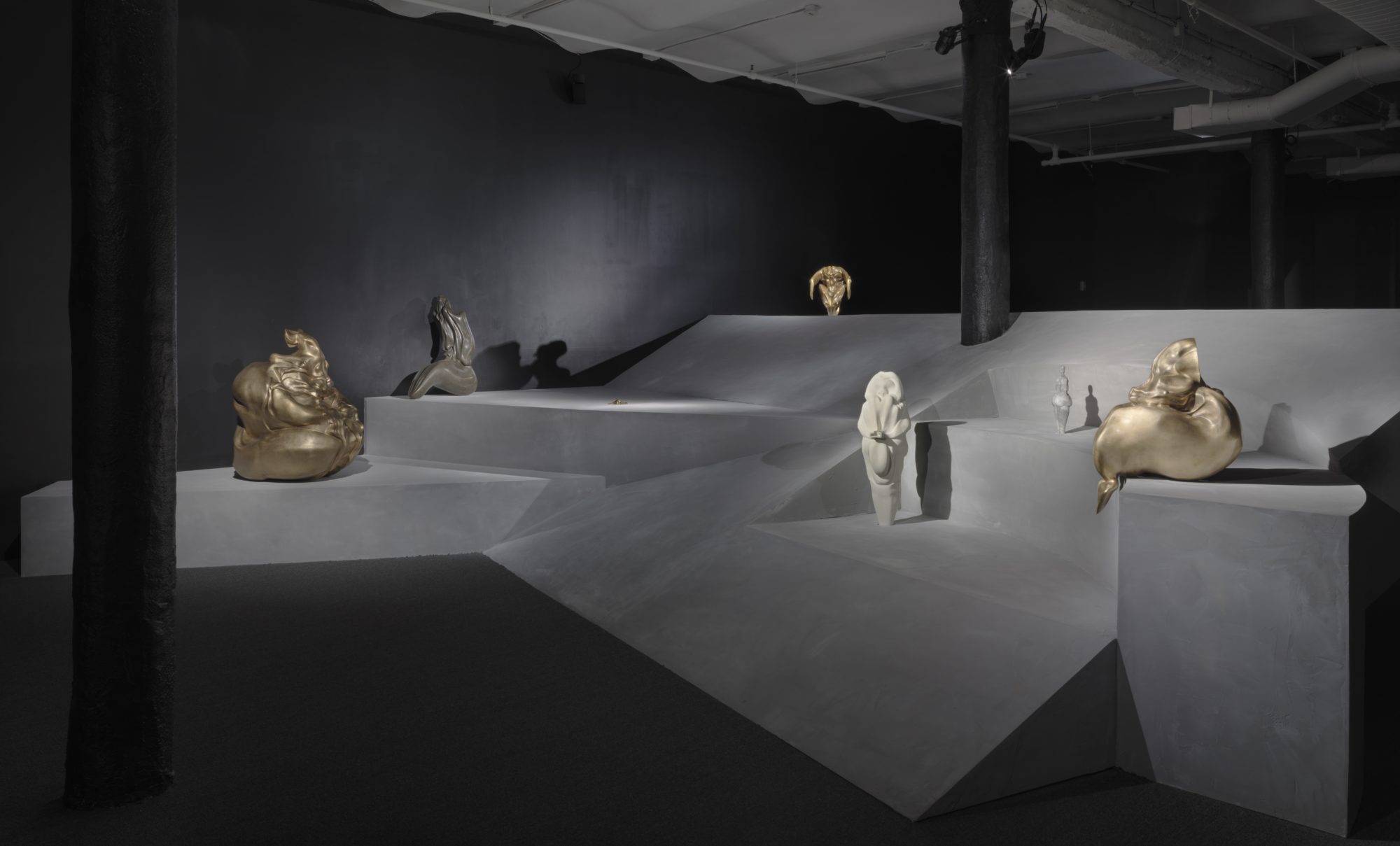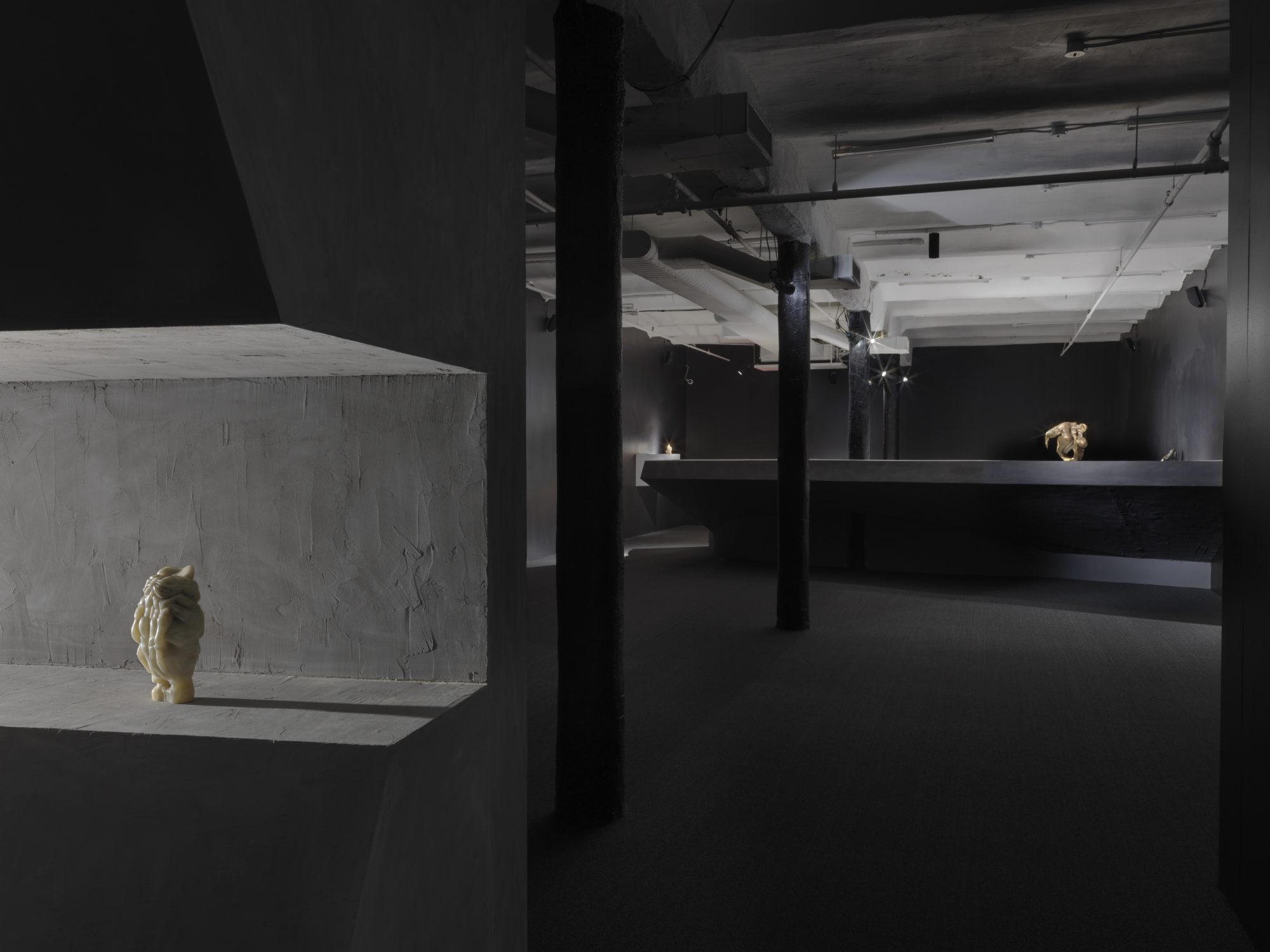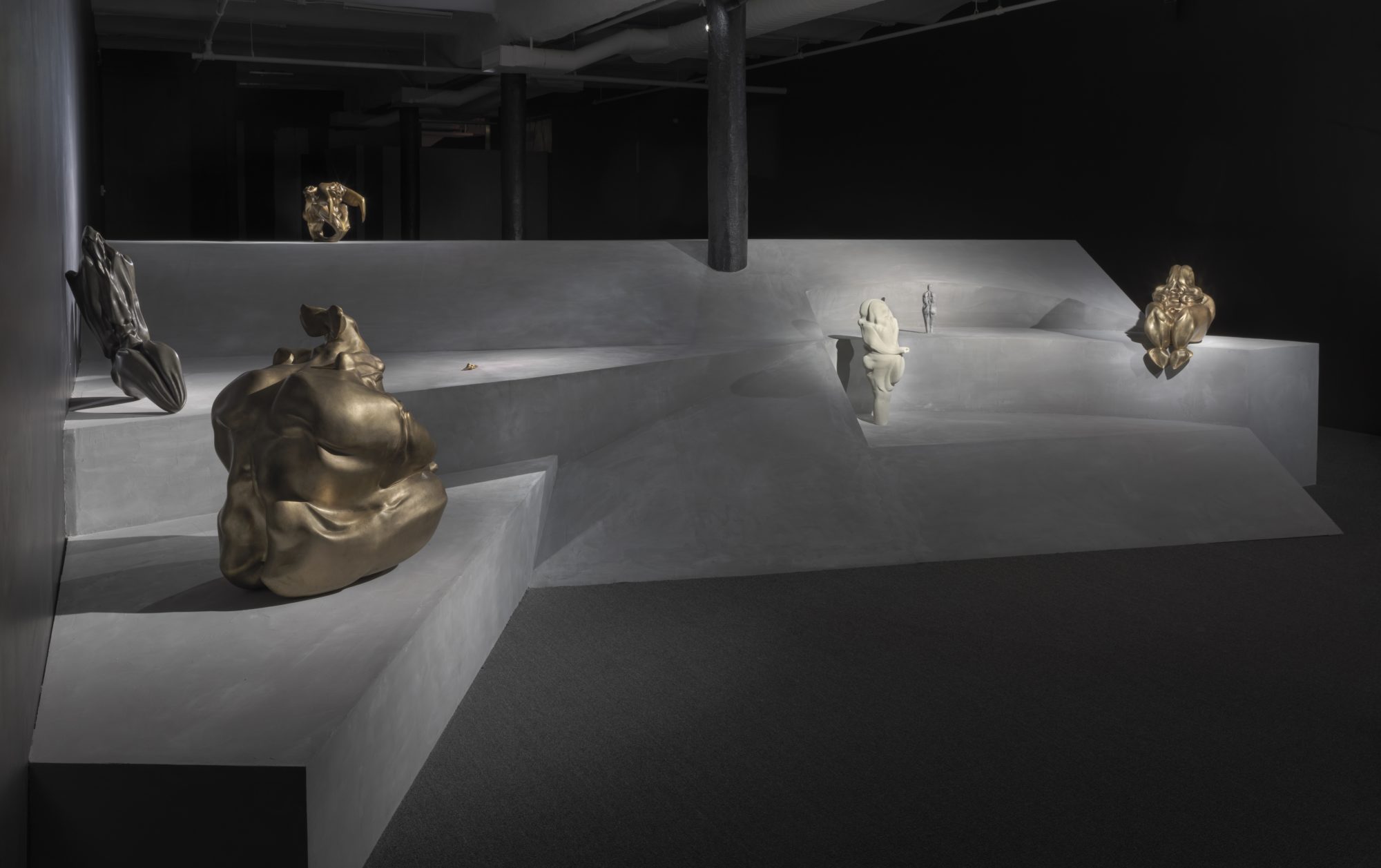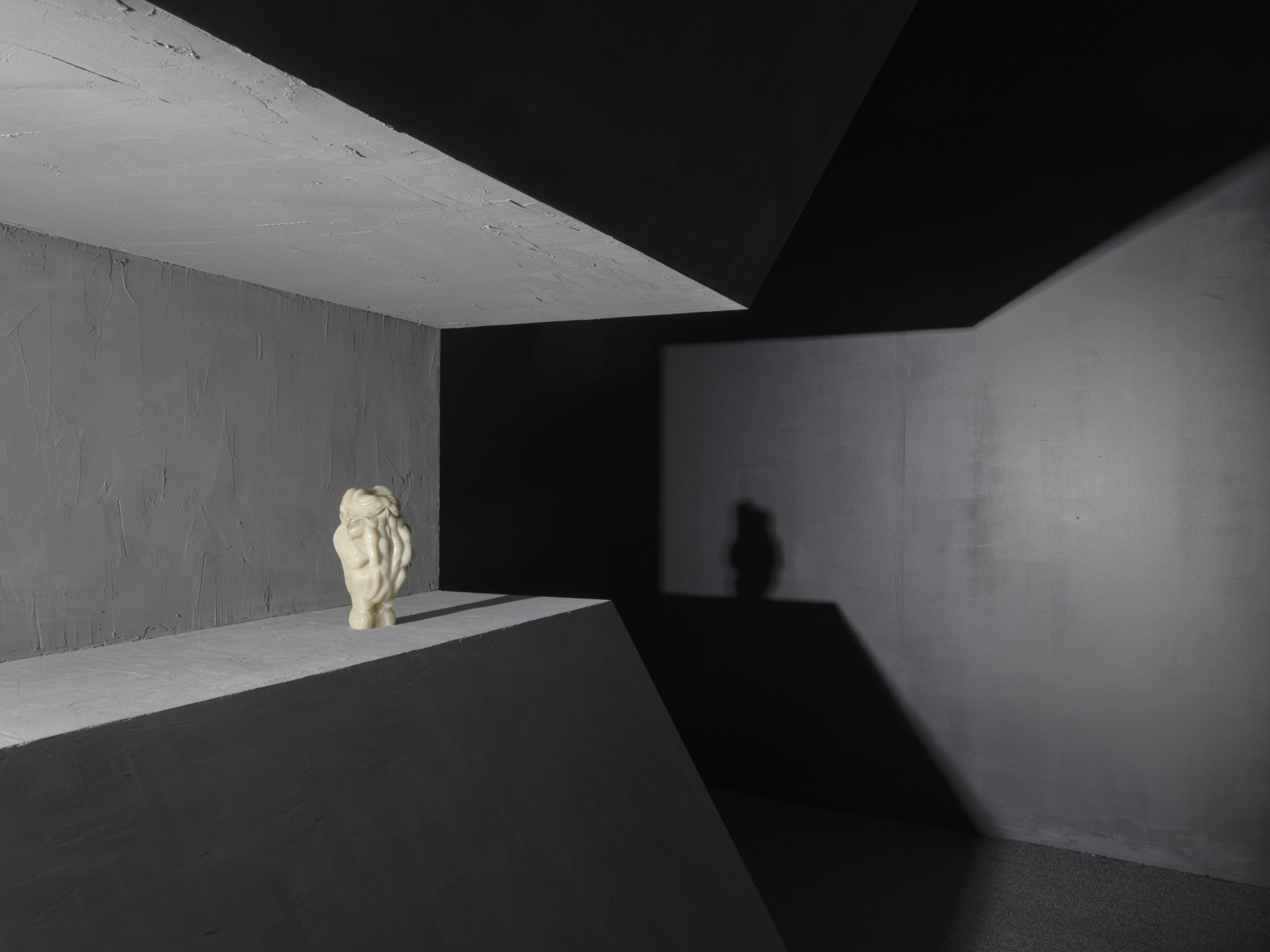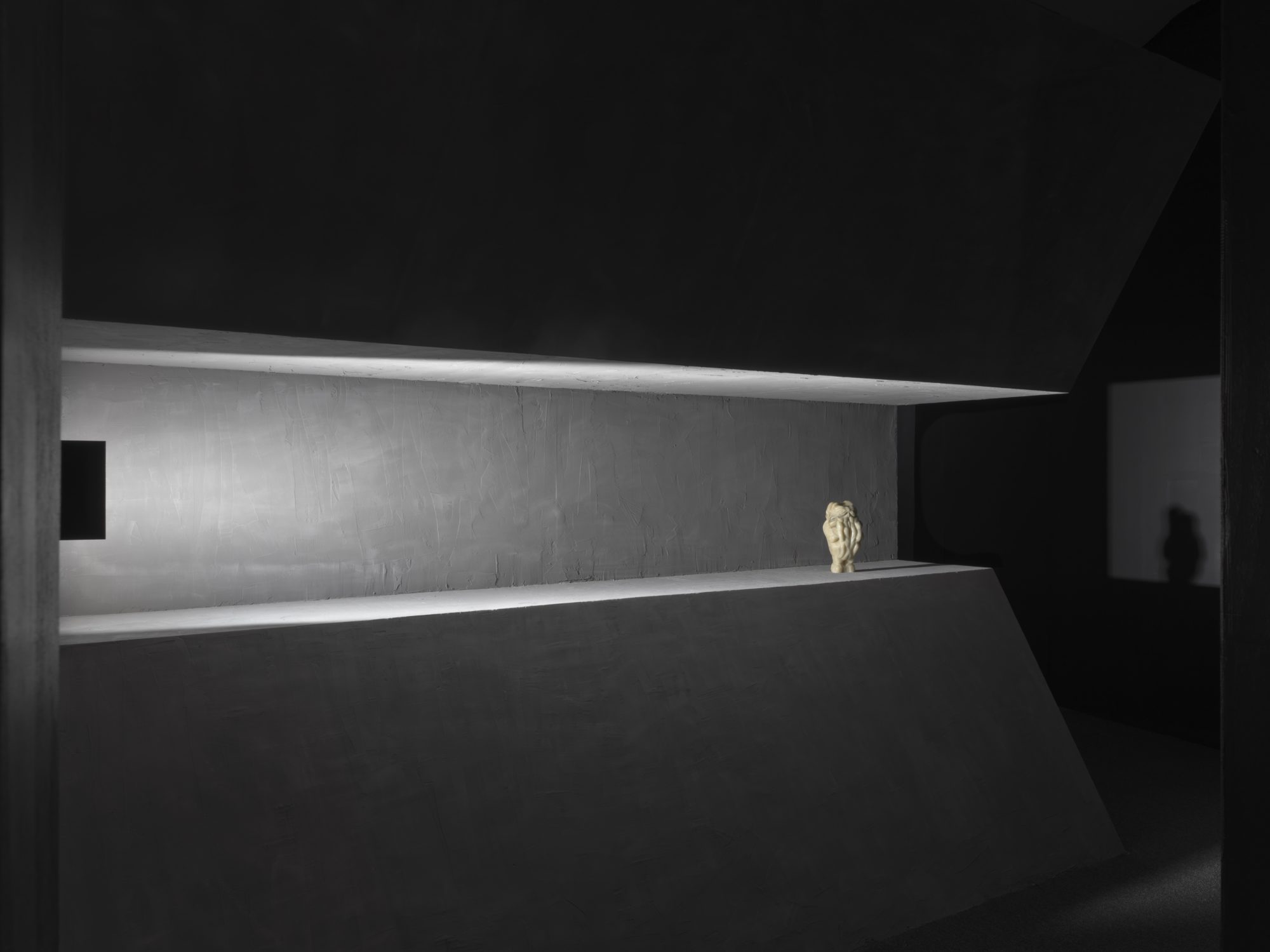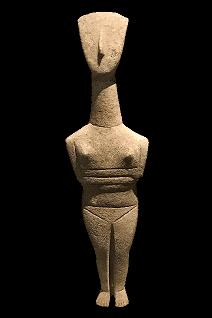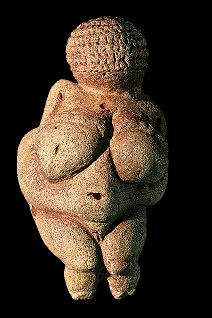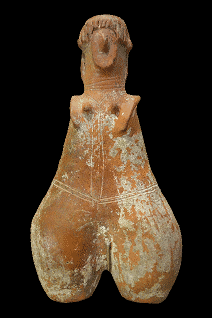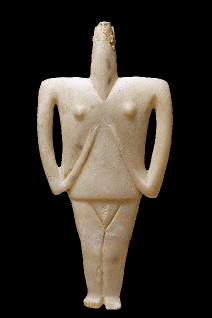Marguerite Humeau, “Marguerite Humeau: Birth Canal,” 2018, installation view [photo: Maris Hutchinson / EPW Studio; courtesy of the artist and New Museum, New York]
Gender and Artistic Practice in the Ice Age
Share:
Deep in the bowels of the British Museum rests a desk with a tray of replicas of ivory carvings between 20,000 and 30,000 years old. Keeper of antiquities and curator of the blockbuster 2013 exhibition Ice Age Art: Arrival of the Modern Mind Jill Cook explains the idea of spiritual landscapes, the surreal continuity between ancient and modern artistic practice, and gender equality in the Paleolithic. Our conversation is a mix of dispelled rumors and reinforced stereotypes. Perhaps the most extraordinary revelation is of the horrific origins of the most common term used for Paleolithic female figurines (and why you should never ever use it).
William Corwin: When you’re standing in a painted cave like Lascaux or Les Combarelles; what is your intuitive feeling for the purpose of decorating these spaces? Why would a cave like Chauvet be painted again and again over 5,000 years?
Jill Cook: I don’t think it is simply art for art’s sake. There’s too much economic investment and time given to it. Such a lot of practice goes into it. Sometimes it is deep underground, and you have a lot of preparation, and you’re putting yourself at risk. If you break an ankle or a leg you’ve got a real problem. These images use places which have a particular spiritual potency; they are a way of accessing and communicating with other worlds. The animals may act as avatars to those other worlds—it’s a way of relating not only to each other and to nature, but to the supernatural.
I think [that] the investment and these other characteristics are about an animate spiritual landscape, and that many of these things occur in places which have a particular potency—that’s why they’re revisited. This is a very distinctive and characteristic feature of human beings. Wherever we are and whatever stage of development we are at, we have practiced some kind of belief system.
WC: Can you hazard a guess as to these beliefs?
JC: It seems unlikely, from what we know about cave art, that belief systems actually anthropomorphized—if I can use that word—turned their spiritual beliefs into human representations. What we understand about belief systems of this period [is] that they are focused in landscape and nature: places and animals have particular spiritual potency. The spirits are not represented: they don’t become gods or goddesses. You go to a place, a cave or a rock prominence, and you sense the power of the spirit, and you acknowledge it there by storytelling, chanting and/or painting. We have no sign that there is a sense of worshipping an anthropomorphized deity.
Marguerite Humeau, “Marguerite Humeau: Birth Canal,” 2018, installation view [photo: Maris Hutchinson / EPW Studio; courtesy of the artist and New Museum, New York]
WC: Can you talk about tectiforms?
JC: In amongst the animals, and sometimes all by themselves, we find marks in caves. These can be dots, or they can be funny little rectangular shapes or triangles. They are often in well-defined locations within a cave system. For example, in El Castillo you get into one of the lower long chambers, and there are dots all along the wall. We have no Rosetta Stone with which we can read these, and sadly they are often completely left out of the conversation. They are probably extremely important, and we get an idea of this by what colleagues in Southern Africa tell us about rock paintings by the San, which are wonderful paintings of eland and hartebeest and elephants and so on.
In the early years of copying these paintings, Europeans would come across little marks which, because they did not know what they were, they would completely leave out of their copying. As people have gone back with indigenous guides, and they have studied early accounts of these people written down by missionaries and travellers who took the trouble to learn their language and record things about them, it has been realized that many of these little signs and symbols are crucial to understanding the meaning of the rock art. David Lewis-Williams, a retired professor at Witwatersrand in South Africa, set up the rock art institute at that university, and he describes them as “nuggets.” He calls them nuggets because often an informer will point to this sign/symbol—which is meaningless to us, and we have completely overlooked it in relation to these wonderful drawings and paintings of animals—and they will say, “This tells me it means this, and relates to that story.”
We are only just beginning to come back to signs and symbols. They’ve been looked at over the years, and it has been considered as to whether they do represent a kind of writing. Ideas have come and gone, but we really await a focused study of these things. The experience of the Southern African art suggests to us that sometimes these little marks may have been the clue to the whole thing. If you were a user of that cave, you would know what that mark on that outcrop was about—what it was telling you. You would know what the line of red dots was; you would know what this little tectiform shape, next to an animal, what story it related to. This is for the people who were in those sites and the people who were using them—they understood and read these things. Again, it’s about art communicating. We can see that in different areas of France there are different marking systems that could well relate to different ethnic groups, and different language groups, and a different way of expression. There’s a huge amount more to do as we become more forensic about these things and really record the details and analyze those details in a variety of ways. Looking at distributions, we begin to see patterns that we then have to question more. Symbols and patterns are going to be great things to be looking at in years ahead.
WC: Do you have a sense that Homo sapiens started making things about 50,000 years ago, or is it a case of perishable materials that are no longer extant? Is it just that it’s impossible to find artifacts older than that?
JC: It is possible to find artifacts that old in Western Europe, and although there are no signs of figurative art prior to about 40,000 years ago, there are indications that Neanderthals used ochre to decorate their bodies along with eagle feathers and perorated shells. People may have been creating fantastic decoration on their skin and making things in materials that don’t survive—we cannot talk about what we cannot see. Equally we tend to give these broad dates which give the impression, “Oh, it’s 40,000 years old: here is art.” It is never that abrupt or revolutionary, that is just the way we bracket it. There are things happening that probably we cannot see, and things that are coming into being over a long, slow period of time and taking root. What we do need to be careful about is simply focusing on Europe.
At Rhino Cave in Bostwana, at 80,000 years ago, we have the wall of a cave which has been deliberately decorated with what we call cupules, cup marks deliberately scooped out of the rock to make a pattern. At the base of this decorated wall there is a cache of pristine stone points: there is decorating and caching at that stage. It is Homo sapiens, and much earlier than anything we know in Europe. Blombos Cave, with the piece of decorated ochre with a geometric pattern on it, is from 89,000 years ago. We now have evidence of cave paintings in Indonesia, which go back a little beyond 40,000 years ago; and in Australia, if only we could sort out the dates, we think there are things at 40,000–50,000 years ago.
Marguerite Humeau, Birth Canal, 2018 (preview image) [Photo: Julia Andréone; courtesy of the artist and the New Museum]
We look at the European record because it has been very well researched, it has been known for 150 years, and we have such magnificent things. It is also easier to preserve things in a temperate environment than in humid tropical environments, so again—we don’t know what we’ve lost elsewhere. There seems to come a point where modern humans spread out across the world, and for whatever reason they began to represent things in ways that we can find. It’s quite probable that they were using personal ornaments and decorating themselves.
Adorning yourself is a hugely important thing to do, because it communicates information about you: it can indicate marital status, beliefs, and that you want to be the main man and look good, to be attractive—all of these things. We all wear jewelry of some kind, whether it’s a smart frame on our glasses, a pin with an American flag or a political affiliation, or we wear a medal to show that at some point we’ve been terribly heroic. Jewelry and accessories that we wear say a lot about us and our relationships to other people in society. Personal adornment certainly goes back before the representational art that we have been talking about.
WC: What about the hand axes?
JC: Let’s start before the hand axes. There’s a wonderful piece from Makapansgat, South Africa, which is just over three million years old. It is a stone, and when you look at it you see a face, because there are two little dimples for eyes—sort of a smiley face. This stone is completely natural, and the face is an accident, but what we can see about this stone is that it is foreign to the site. There are no natural processes that could have carried that stone from where it occurs to the site on which it was found. In Makapansgat there are also skeletal remains of a very early ancestor called australopithecines, and it seems most probable that this stone, because of its “face,” was picked up, carried, and dropped at Makapansgat by these early hominins. This shows us that from a very early stage there is evidence that great apes and early hominins have the capacity to recognize facial features.
Chimpanzees and gorillas, our nearest relatives, are similar to us in that they would see you, and they would recognize your face. Like us they also recognize themselves in a mirror. What’s interesting about this Makapansgat stone and it being carried shows that, after the split which happens 5–6 million years ago between the great apes and the lines which evolved into humans, the branch which leads to us shares this characteristic with the great apes. So, from a very early stage human ancestors had brain characteristics that enabled facial recognition..
We then start to make stone tools, and when we come to hand axes, what is striking about some of them is that they are symmetrical, they’re very thin, sometimes they are very large, and sometimes they are made of ridiculous materials. For example, some are made from quartz: quartz is nearly as hard as diamond, and it is very difficult to work. Unlike flint, which has a nice smooth texture, quartz has a crystalline structure, so when you hit it with a hammer, unless you are very precise and accurate and have your blow at exactly the right angle, the force of the blow will not dissipate evenly through the material and lift a flake off. If you are not exactly right, the force of your blow will just run out through the crystal boundaries, and you will remove crumbs. When you see a beautiful almond-shape quartz hand axe with lovely straight edges, which is beautifully thin, that is a masterpiece: a superb piece of craftsmanship that requires great skill.
Marguerite Humeau, “Marguerite Humeau: Birth Canal,” 2018, installation view [photo: Maris Hutchinson / EPW Studio; courtesy of the artist and New Museum, New York]
JC [cont.]: Through experiments that have been done in Europe, the United States, and in Africa, making hand axes and asking people who are skilled butchers to use them, if you make a range of hand axes, some of which are not these very symmetrical, thin, straight-edged forms, you will find very often that the skilled butcher will choose something completely different. The characteristics of the masterpiece don’t actually make it suitable for cutting up your lunch or skinning an animal. You want different characteristics in an edge and in a tool. We have many hand axes that are perfectly good tools, and they’re not finished to that degree of skill. So interest in symmetry and aesthetics is a real thing: symmetry is an early characteristic of the brain, so we shouldn’t find its presence surprising. Like facial recognition, it is one of these things which is a characteristic of how our brain responds to what we see and what we like. What is interesting is that we are then materializing what we like, which is a first step in the artistic process; it is about externalizing and materializing what we are thinking about.
When you use a material which you’ve carried from a long ways away, and one which is difficult to work, and then you produce a beautiful thing—why have you done that if it isn’t going to help you get a meal? We have talked already about art being a form of communication: these things perhaps are an attempt to communicate. Communicate what? Some people have speculated that this might be a way of someone showing how skillful they are. In other words it’s like wearing a Cartier ring or a Rolex watch. It says, “I’ve got money, and I’d be a good mate because I can give you lots of things. I can provide.” It may be that working a material—a strange rock that looks very pretty and attractive in itself—and producing this beautiful thing, says, “You know, I’m a really skilled person, I know the landscape so well, I can bring this stuff back.” That is all information that would make someone a good mate. Rather like sending a love letter or a painting; being indicative about your wealth and status.
We have some hand axes which are 30 centimeters or larger. I don’t have big hands. My hands are about the same size as some of the early hominids’ and I would find it difficult to use the large hand axes in any way at all and many of these show no traces of utilization! There is a completely non-utilitarian bunch of objects which I don’t think we can call art in the sense that we understand it now, but it is a step towards materializing what is going on in our heads. We are thinking: “she looks nice, how can I impress her?” Then we are materializing that into a shape and an object. There is this basic requirement: “I need something to do that job,” and then you materialize that thought into an object. That’s the hugely important moment. That is the moment of materializing ideas, and that is crucial to the subsequent development of what we recognize as representational art—the beginning of our capacities for making symbolic things. Our ability to recognize faces, our pleasure in symmetry, and this capacity to translate ideas into actions and objects.
WC: This is very ancient creativity. Let’s talk about more “recent” work. Do you get a sense of artists exchanging ideas? I know it’s a limited sample set to look at, among the sculptures being made 25,000–30,000 years ago, but were artists looking at each other’s work? Were they training each other? Was there a sense of aesthetics?
JC: Yes. The confidence with which a great many of these works were done—we know these were the works of people who practiced. Very often the line of the back of an animal will be rendered with one stroke; the proportions and the scale will be correct, and the markings on the pelt will be precisely represented. This isn’t created by someone who simply takes up their stone engraving tool and draws; this isn’t scrimshaw. It isn’t casual in any sense—we can say this with certainty as we do much more forensic work.
Marguerite Humeau, “Marguerite Humeau: Birth Canal,” 2018, installation view [photo: Maris Hutchinson / EPW Studio; courtesy of the artist and New Museum, New York]
WC: What do you mean by “forensic work” in this context?
JC: A close look using microscopy and using techniques which will help detect whether any coloring material has been used. It involves looking at every line on the drawing. Through this we’re beginning to detect the work of particular artists.
WC: Really? You can see a hand?
JC: You can see a hand. Looking at portable pieces made from bone antler and ivory, as well as on stone, we’re beginning to detect a certain amount of training within these drawings. One of the problems with mainstream picture books is that they don’t often show the pieces that aren’t all that “good.”
WC: You’re talking about “bad” Paleolithic art?
JC: The sort of drawing I would be able to make because I’m not a practiced artist. “It’s a cat because I say it is, not because it looks like one.” I’m not competent to reproduce a cat. We are beginning to detect that there are pieces that are less competent, and that there is a process: there are conventions for how you do things and where you start with the drawing of an animal. Within specific time periods there are particular ways of shading and reproducing the animal. In Chauvet Cave you have what could almost be called a fingerprint: one of the artists who is doing the drawings on the wall has a problem with their finger. You can follow him or her, wherever he or she goes, because you have that fingerprint, and we can attribute particular images to that artist.
That careful and detailed work is enabling us to say that some of this magnificent material is the work of extremely competent artists who have had a lot of practice. That is a considerable implication. Here’s an example: the “Lion Man” from Stadel Cave in southwest Germany, 31 centimeters high, is made from mammoth ivory—all ivory is extremely difficult to work, because it has the structure of an onion: with concentric rings which are cemented together—to cut across and work through that hard material requires a great deal of skill.
WC: Does it take a long time to work?
JC: It does. The “Lion Man” has been replicated by a skilled ivory sculptor, and it took him about 400 hours. It is not because he wasn’t used to the material or he wasn’t experienced, but [because] using stone tools and reproducing the piece in ivory took that long. It is an enormous amount of time. We can also see from the piece that the person who made it had worked a great deal in ivory.
WC: Were there little tricks that they used?
JC: Yes, and these show the person’s experience. For example: to make the piece faster and to separate the legs, the artist knew where the cavity of the tusk was, underneath the surface. By grooving and knocking out the spall the process was shortened. To cut the legs apart would have taken a very long time, but knowing that cavity is there means you’ve worked that material before. These people were practiced and skilled, and that has significant implications about the social buy-in to the object. Somebody is being allowed to fabricate these objects, and that process is not economic: it does not feed you or keep you warm but you regard the work as sufficiently valuable, interesting, and significant to allow it to go on. You are investing in that, and that suggests that there is a value and a significance within the group: a buy-in to the idea and its meaning.
Of course, all art communicates. To use an analogy, here in the UK, advertising for the 2012 Olympics put a cheetah’s head on an athlete’s body. Without any words, that advertisement said “power,” “aggression,” “speed,” “strength,” and “competition.” That poster communicated all of those things, just as the “Lion Man” communicated in its day.
Marguerite Humeau, “Marguerite Humeau: Birth Canal,” 2018, installation view [photo: Maris Hutchinson / EPW Studio; courtesy of the artist and New Museum, New York]
WC: How was the lion man found? Was he found in a position of veneration?
JC: The latest work on the piece has shown that the surface of the body is polished through handling, so for some part of its life, the “Lion Man” was passed around; perhaps as a vehicle for storytelling. The ivory became rubbed and worn by greasy fingers. After this use, for whatever reason, they needed to put it away, and they went into the back of the cave, into the darkness, and they carefully buried it there. There was nothing else around. There were a couple of perforated arctic fox teeth which were personal ornaments, but those were the only other things in the dark recess of the cave. In the daylight at the front of the cave there was more activity, fireplaces, bones from food remains, and lots of stone tools. However, the cave faces north, bad choice for habitation because it is constantly in the shade. This is reflected in the fact that the density of artifacts in Stadel Cave is much less than in other sites in this area of the Schwabian Alps that are south or east facing. Stadel Cave seems special in this respect. Perhaps chosen for ceremonies and rituals because it would not attract normal habitation. The “Lion Man” was placed in the darkness, in the back of the cave, where there wasn’t any other trash. We all understand that art communicates, and here it is, 40,000 years ago, communicating big time and performing a social function to help people bond and socialize and commit to ideas which perhaps were psychologically beneficial to the maintenance of the group.
WC: Was there a clear sense of gender roles in Paleolithic society?
JC: We have to remember that the way we experience gendering in our own societies and, indeed, in all agricultural and urban societies is a very particular consequence of how we live: we perceive of male and female roles. It’s reasonable to question whether this perception actually existed in deep history. In many surviving indigenous communities we don’t see that same definition of male and female in terms of gendered roles. Everybody needs to obtain food, and in cold environments everyone needs to sew and keep the fire going. There will be tasks that go on in base-camp: the preparation of skins, tool making, caring for children. Taking children hunting is not a good idea, so with the feeding and caring for children, it’s likely that women and perhaps older or injured men are the base-camp people. The perception of that is probably not the same as we have of gender in modern society: surviving as a hunter/gatherer is a collaboration.
Among recent arctic communities in Eurasia there is no concept of male/female superiority or the measuring of activity values. However, because men have often been the ethnographers who have done the recording, it will be the male role that’s talked up; “man the hunter.” In actual fact, when you look at what’s eaten, the hunted animal will be the least contribution to the menu. Everybody gets very excited because it’s great to have the meat when it comes, but in between they’re relying on the things collected by the base-camp people: bird’s eggs, vegetable materials, small mammals and birds. It’s possible that at some of the sites women are doing a lot of the fishing. Down in the Aveyron Valley in France we have a site which is right on the edge of the river. There are lots of hooks for line fishing, as well as fish gorges. Along with numerous sewing needles, there must have been preparation of all kinds of cordage.
You wouldn’t consider a man’s contribution the more important. Women may have had to do a great part of the sewing, but a man wouldn’t go out without a sewing kit in his pocket because if he tears his shoe or his coat and he can’t repair it, frostbite is death. There’s a much better distribution and understanding of roles within the society, so it tends to be agriculture which puts up some of the barriers to what women can do and what their roles are.
WC: Within this context of all hands on deck, where does the craft person fit in?
JC: If only we knew. It’s quite possible that the kind of female figurines that are made between 20,000 and 30,000 years ago are made by women, for women. They often turn up by the fireside or in pits in domestic settings, and some of them relate to pregnancy and childbirth, but that’s almost as extreme a reading as saying they’re made for men because they are erotica—those things are the opposite poles. These figures may have been about the changes in women’s bodies through their lives, they may have been important in women’s rituals. But, successful childbirth is as important to the father as it is to the mother!
Marguerite Humeau, “Marguerite Humeau: Birth Canal,” 2018, installation view [photo: Maris Hutchinson / EPW Studio; courtesy of the artist and New Museum, New York]
WC: And why should we stay away from the “Venus” moniker for these objects?
JC: How long have you got? People think of it as “Venus, goddess of love,” and, thus, what you’re looking at is some piece of erotica. [holds up a replica of a Paleolithic figure] This is a copy of the famous figure from Willendorf in Austria. Last time I looked there were something like 5,000 websites with material relating to her … even soap on a rope. Let’s look at her: unlike a model in an erotic context, she doesn’t look out at you and catch your eye, she looks down. She doesn’t place her hands on her pudenda or her breast like a Roman or a Greek Venus to say, “I’ve got your gaze, you follow where my hand is and see the sexy bits.” With her big hips and thighs, her drooping breasts and tummy, and her downward glance (which is terribly modest), she doesn’t look erotic at all. She looks like a woman who’s done quite a bit of childbearing and has got a bit older. A grandmother, a wise woman to impart knowledge and experience to those around her.
The first female sculpture to be found in 1864 was actually a very slim ivory figure, a young woman. She doesn’t have very big breasts; she’s actually quite flat-chested, but she’s clearly nude. The Marquis de Vibraye, who found her referred to her as an immodest idol. A few years later, when some of these figures with the large hips, thighs, and breasts started to appear, that was changed to Venus. Again, it is not related to erotica, it is related to the sad story of Saartjie Baartman, a San woman brought from South Africa to London and put on display down near Covent Garden. The world could come and look at her as a curiosity. She smoked a pipe and spoke Dutch. She was a very large woman, with large breasts and large buttocks, big thighs. There was a particular fascination for her sexual parts—she had large labia on her vulva, and this was considered very interesting. Because she was a black African woman, this was considered to be proof that she was licentious, promiscuous, and not at all modest like nice English ladies.
Saartjie Baartman became crudely and ironically known as the ‘Hottentot Venus’, and she ended up in Paris, where she died. In Paris, she had again been exhibited for anatomists to poke and prod. Her body was illegally taken by the paleontologist Baron Cuvier, who took a cast of her body and dissected her so that her sexual parts were kept in spirit jars on the shelves of the Musée National d’Histoire Naturelle in Paris.
You want to be at the top of the evolutionary tree; you want to see something as old, as savage, as other, as brutal and nasty—all the things you can lay on it, so ironically, these figures became called Venus figures.
WC: How many are there of these figures now?
JC: There are about 155, of which I’ve seen 130. The thing about them is they represent women in all stages of their lives: thin pretty sexy ones, ones who are pregnant for the first time, ones who are pregnant subsequent times, ones that are actually giving birth, grandmothers. They represent all stages of women’s lives—every single one of them is different. That doesn’t stop them being goddesses, if you think of images of the Virgin Mary, a Cranach version is quite different from a Raphael, or something more recent. We need to be more careful, more objective, and say this is a sculpture of a woman. Saying it’s a Venus assumes it’s a goddess, assumes it’s about erotica, made by men for men and we’ve just demolished all of that, so it is an inappropriate name, and it truly needs to go.
The images accompanying this interview are from artist Marguerite Humaeu’s current exhibition “Marguerite Humeau: Birth Canal,” at the New Museum in New York. The exhibition is on view from Sept. 4, 2018 – Jan. 6, 2019.
From the New Museum’s exhibition details:
For “Birth Canal,” Humeau studies the origins of Venus figurines, prehistoric female goddess statuettes found throughout the world. Her research expands on the idea that early modern humans may have ingested animal brains for their psychoactive effects: in this theory, Venus figurines functioned as recipes, marking out an anatomical guide for shamans and those seeking spiritual ecstasy through altered consciousness. In her installation, Humeau envisions a scene from 150,000 years ago, when Mitochondrial Eve, the most recent matrilineal ancestor common to all humans, is estimated to have lived. Ten digitally rendered sculptures, meticulously realized in cast bronze or carved stone, beckon the viewer into a dark space that smells faintly sweet and mineral-like, its odor inspired by bodily liquids associated with birth. Formally ambiguous, the sculptures resemble both brains and Venus figures, and represent shamanic women of different ages. Seen and heard in an ominous state of polyphonic trance—part convocation, part choral lament—they prophesy the future extinction of their offspring, humankind. With allusions to animism, totemism, and spiritual travel, Humeau’s installation creates a forum for these imagined voices and premonitions, underscoring the brevity of human existence relative to cosmic and geologic time.
Following its debut at the New Museum, Humeau’s exhibition will travel to Kunstverein Hamburg in February 2019, and Museion, Bolzano in September 2019.
